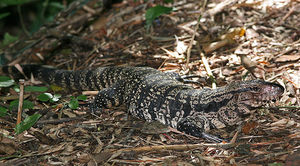Black Tegu
| This article is still under construction. |
Scientific name: Tupinambis teguixin
Other common names: Common Tegu, Colombian Black and White Tegu, or Gold Tegu
Description
Adults around 1 metre. Have been recorded up to 1.5 m.
Tegus are large powerfully built ground-dwelling lizards with stocky bodies, pointed snouts, short strong limbs and sharp claws. Though they rarely climb they are prodigious burrowers. Black tegus are attractively marked with bands and stripes of white on a shiny black dorsal surface. Older males often develop enormous heads and strong jaws. The long tongue is bright red and forked. Like monitors, the tail is not capable of regeneration if lost or damaged and is used as a fat reservoir.
Range
South America. Tegus are the New World equivalent of monitors.
Diet
Omnivorous
Freshly-killed small mammals are probably the best option though chicks can be fed. Eggs, invertebrates, fruits, leaves and some vegetable matter should be offered. Supplement. Young animals may be fed on large invertebrates (black crickets, locusts and giant mealworm). Feeding of tegus is rarely a problem. Obesity is common in captive teiids due to over-feeding and cage-induced lethargy.
Enclosure
Always provide tegus with the largest possible enclosure. A powerful heat source is essential. A sizeable water container is required (tegus are excellent swimmers; however a pool is not essential in tegu maintenance).
Being burrowers, a thick layer of substrate may be useful and provide ample hiding places. Various large branches and rocks should also be provided.
Humidity 70-85%
Temperature
30-35ºC +/- 5ºC
Longevity
Tegus may live for 10-12 years.
